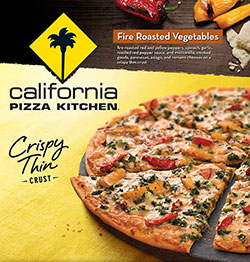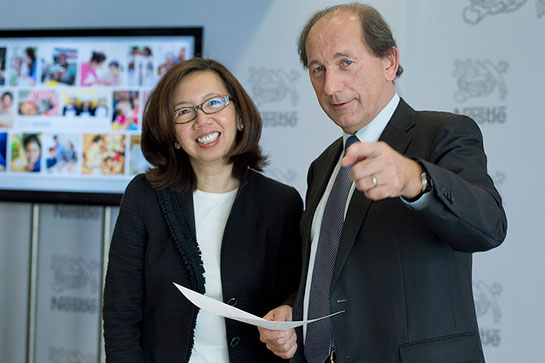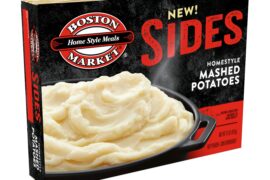Describing 2014 as “indeed not an easy year,” Nestlé CEO Paul Bulcke was nonetheless pleased to report that the Vevey, Switzerland-headquartered multinational company’s net profit amounted to $15.3 billion.
“I have to say that I am proud of the group’s results,” he told financial analysts during an earnings call on February 19.
Earnings per share were $4.78, up 45% over fiscal 2013’s result, thanks in part to the sale of Nestlé’s stake in L’Oréal and the revaluation gain on the 50% of Galderma already held when the group increased its ownership from 50% to 100%. Underlying earnings per share rose 4.4% in constant currency.
Performances on the frozen food front were mixed both in terms of categories and markets. In Europe frozen pizza sales fared well, while in China it was ice cream that shined, though not as brightly as in 2013. The Nestlé Professional unit achieved solid growth in emerging foodservice markets around the world, driven by greater demand for dessert solutions such as frozen cakes.
 Nestlé is targeting the at-home breakfast market in the USA with this new Turkey Sausage Scramble offering distributed under Lean Cuisine’s Morning Collection range. However, increasing sales of Nestlé frozen food brands in the USA market, where the category has slumped by 2% to 3% in the retail sector during recent years, continues to be challenging. Why is this, and why is Nestlé repositioning its flagship Lean Cuisine line of ready meals and entrees?
Nestlé is targeting the at-home breakfast market in the USA with this new Turkey Sausage Scramble offering distributed under Lean Cuisine’s Morning Collection range. However, increasing sales of Nestlé frozen food brands in the USA market, where the category has slumped by 2% to 3% in the retail sector during recent years, continues to be challenging. Why is this, and why is Nestlé repositioning its flagship Lean Cuisine line of ready meals and entrees?
Because, Bulcke declared, consumer expectations have changed dramatically in North America.
“Frozen is not perceived [to be] fresh, although it has all the intrinsic freshness in there,” he said. “That’s why we have this campaign, Freshly Made, Simply Frozen. It is to also go digital to get the right message across and support our brands much more.”
Noting that the frozen category in the United States has been “a little bit starved of brand support” and driven by special deals and discount pricing, the chief executive officer remarked: “People don’t buy prices, they buy value. We have to get that back, and that is what is being done.”
He continued: “We are seeing that the whole lean market – not only in frozen – in general is challenged. People don’t want to go only for diet, they want to go for healthy lifestyles. And that’s where Lean Cuisine has to move into, and is moving into…The trade has a very high acceptance of all the plans we have. That is boding well for the acceptance also of consumers. So we see that accelerating throughout the year…We have plans that are rolling – being rolled out as we speak.”
CFO Montello Comments
Wan Ling Martello, Nestlé’s chief financial officer, also addressed frozen food market issues after first pointing out the company’s relatively strong performance in sales of super-premium ice cream, coffee creamers and pet care products in the United States.
 Crispy Thin Crust California Pizza Kitchen products sold relatively well for Nestlé in North America during 2014.“This growth was offset by the continuing contraction of the frozen category and further declines in premium ice cream,” she told analysts. “In frozen pizza, the category dynamics, in addition to our pricing, led to a disappointing slowdown. This was despite the innovations we brought to the market. Our California Pizza Kitchen brand did relatively well, particularly with crispy thin crusts.
Crispy Thin Crust California Pizza Kitchen products sold relatively well for Nestlé in North America during 2014.“This growth was offset by the continuing contraction of the frozen category and further declines in premium ice cream,” she told analysts. “In frozen pizza, the category dynamics, in addition to our pricing, led to a disappointing slowdown. This was despite the innovations we brought to the market. Our California Pizza Kitchen brand did relatively well, particularly with crispy thin crusts.
“Looking at ice cream’s performance, the premium segment remained under pressure. I can tell you, though, that the super premium segment did well with Häagen-Dazs Gelato. Our snacks business, that includes Drumstick and Outshine bars, recovered nicely also.”
Martello expects to see “some recovery” in the USA market during 2015 as Nestlé’s portfolio is revamped and further segmented with emphasis on snacking, natural, gluten-free and higher-protein products.
From Mao to Ma: E-Commerce Revolutionizes PRC
Looking across the Pacific to China, where expansion is slowing overall, growth was nonetheless achieved last year in the company’s second largest market. In a nation where e-commerce has had a major impact on retail sales at the expense of traditional brick-and-mortar stores, consumer goods manufacturers and retailers are having to adjust their distribution and merchandising strategies accordingly.
This goes for Chinese property tycoons as well as foreign multinational conglomerates, as Wang Jianlin’s $40 billion Dalian Wanda shopping centers and entertainment firm and $25 billion in personal wealth ranks second to e-commerce titan Alibaba’s Jack Ma as the richest and most dynamic force of capitalism in the PRC. But that’s another story.
“The fact [is] that e-commerce is offering new platforms, new products, new categories [that] are kind of wrong for the traditional dimensions of our portfolio,” stated Bulcke. “That is what has impacted us. We have to make a reconnect there. And that is for the whole market and mix, and we have done that. It is now in the process of being rolled out…”
Having said that, the chief executive officer added that e-commerce is not taking over across the board, as most Chinese consumers still like to touch and feel products as they comparison shop.
“We still have very good growth and very strong brands there are going well in many areas,” Bulcke told analysts. “Some have weakened. They still connect with consumers. We just have to add that additional new expectation [for] the consumer and build that in, in our brand architecture. E-commerce has gained a lot of traction, it’s true. E-commerce has different portfolios that are offered that may wrong foot the traditional dimensions of the consumer product landscape. That’s where we want to reconnect. These are adjustments, some deeper than others, that we are making. But we are engaging definitely in e-commerce as a trade channel in China.”
 Nestlé CEO Paul Bulcke (right) is “proud of the group’s results,” and CFO Wan Ling Martello expects to see “some recovery” among the company’s frozen food brands in the United States.
Nestlé CEO Paul Bulcke (right) is “proud of the group’s results,” and CFO Wan Ling Martello expects to see “some recovery” among the company’s frozen food brands in the United States.
The CEO added that e-commerce will be “proportionately more important in developing younger markets, where you don’t have such a strong retail base yet. It’s a little bit like the cell phone, how these markets or these countries are jumping stages. And that’s why we are engaged in digital, be it social media, because they are intimately linked to each other and e-commerce. And that is also part of the answer we give in China, building these capabilities in an accelerated way and engaging with the big e-commerce players proactively and in certain dimension partnerships.”
For the record, Nestlé’s organic growth in the Asia, Oceania, Africa zone was +2.6% in 2014, while the profit margin was 18.7%. This compares with +5% and 18.8%, respectively, in the Americas zone, and +1.5% and 15.3% in the Europe zone. – Reported by John Saulnier
[Editor’s note: FrozenFoodsBiz.com thanks Seeking Alpha for transcribing Nestlé’s February 19 earnings call and making portions of same available to our readers. The full text may be accessed by visiting www.SeekingAlpha.com. The company specializes in equity research, with broad coverage of stocks, asset classes, ETFs and investment strategy.]





